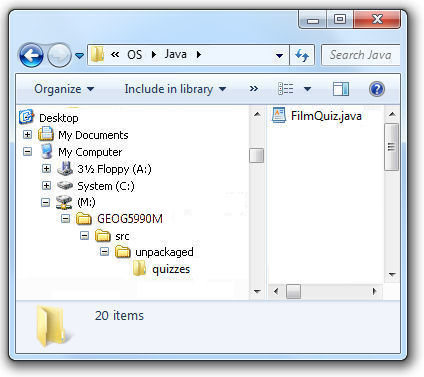Getting started
[Introduction practical]
In this introductory practical, we'll run the java compiler and interpreter on some pre-existing code, so you can get used to the process, then we'll have a go at "Hello World".
Make sure you've got the following software before attempting the practical: Windows Explorer; Command Prompt; JDK; Notepad++; Firefox or Chrome.
First, we need a directory structure:
Before we get going, we need to make ourselves a directory structure for our files (if you are unsure how to do this, see the Windows Explorer tutorial).
Make a directory called 'GEOG5XXXM' (where 5XXXM is replaced with your course code if you have one, or just something like java if you don't). Make this somewhere relatively simple to get to on your hard-drive (we'll assume you do this directly on a drive called 'm', but you might do it on 'c' if you're on your own machine).
Inside this directory, make another called 'src' (for "source code"). In this make one more called 'unpackaged', and within this, one called 'quizzes' (note the letters should be lower case).
This may seem bizarre, but it has to do with an important Java naming convention we'll be using in the future.
You should end up with something like this ---->

Next download the Java file:
Download it into the 'quizzes' directory you've just made. The file, can be downloaded from the following link: FilmQuiz.java. If you aren't sure how to download the file from this link, check out the Web browser tutorial.
You can now open the .java file in Notepad++, and have a look at it (see the Windows Explorer tutorial). Try to work out what it's likely to do - obviously 90% will look like gibberish, but some of it should make sense.
Now open up a 'command' prompt.
Again, see the Command Prompt tutorial if you don't know how to do this. When you open it, it will probably look something like the screenshot to the right.
The c:\> bit is where you type. It shows you where you are in the directory structure. For the command prompt shown in the diagram, the user is on the c: drive and not yet in any directories.
You need to move to the drive and directory where you saved the FilmQuiz.java file.
Once in the prompt window, type the letter of the drive your 'quizzes' directory is on, and then type a colon.
For example...
> m:
And hit return. Your prompt should now say something like
M:\>
This has moved you to the new drive.
Once at the drive, change to your 'quizzes' directory.
Type:
cd \GEOG5XXXM\src\unpackaged\quizzes\
Again, replacing GEOG5XXXM with whatever you called this directory. This command will move you into the 'quizzes' directory.
Type
dir
You should see the FilmQuiz file.

Extra: note that you can use the notation mentioned above with the cd 'change directory' command to move around. Once in your quizzes directory, try:
cd ..\..\
cd \
cd \GEOG5XXXM\src\unpackaged\
cd .\quizzes\
Note also that you can use Windows Explorer to navigate to the directory, and use the Shift + Right-click "Open command window here" option to save navigating at the command prompt (though it's a useful skill for later).
We'll now compile the code into bytecode for a JVM:
To do this, type:
javac FilmQuiz.java
Java is case-sensitive, so make sure you type it exactly as it is. It it works, the system won't tell you anything, it will just quitely move to the next line (if you're on your own machine and it doesn't work -- and this is quite common -- check the JDK tutorial for details of how to fix any problems).
If you're in our local lab, and it doesn't work, the command line might be having trouble finding the compiler. In this case you'll have to type (or better, cut-and-paste) the full compiler path, thus:
"C:\Program Files\Java\jdk1.8.0_45\bin\javac" FilmQuiz.java
Note the quote marks around the path because it contains a space in "Program Files (x86)".
Hopefully you have now compiled your file. If you now use 'dir' to view the directory contents, you should see a new file 'FilmQuiz.class' (there are actually two class files generated from this code; this is fairly unusual). This '.class' file contains the Java bytecode. This is what you will run and distribute to people.
Finally, we'll run the bytecode using the interpreter:
To do this type:
java FilmQuiz
Again this is case-sensitive. Note that there is no '.java' or '.class' file extension used here, even though it is essentially running the .class file. You should see a pop-up window appear (again, if this doesn't work at home, see the JDK tutorial).
If this doesn't work in the lab, try typing (all on one line)
"C:\Program Files\Java\jdk1.8.0_45\bin\java" -classpath . FilmQuiz
which is the full path for the interpreter. The "-classpath ." bit tells the JVM to look in the directory where you are / your files are for the class file. Java should normally do this itself, but try it just incase.
Hint: You should be able to use the up and down keys on your keyboard to cycle through previous stuff you've typed, which you can then edit - saves you typing the command each time.
You should now see a little quiz window, with some quotes in it.
Obviously, as a developer, the process is much more involved than just clicking on an icon to run a file. We'll talk about how to set things up for a normal user at the end of the course.
Have a play around with the application and compare it with the code in the .java file, then go on to Section 2, where we'll tackle HelloWorld.